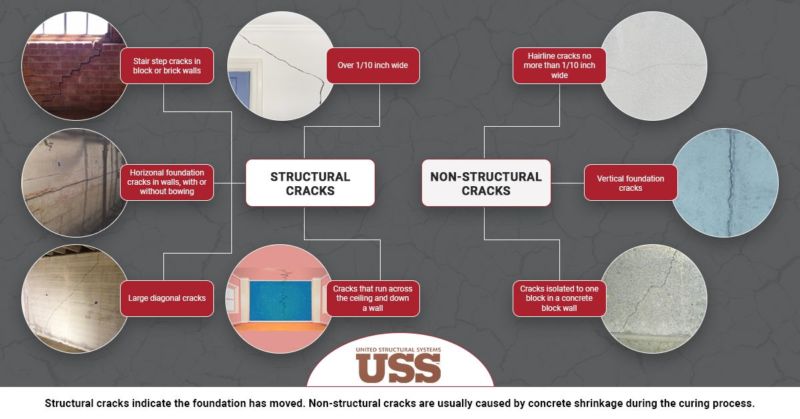Do you have a cracked foundation? If so, you’re not alone. Foundation cracks appear in both newly built and existing homes. The good news is that a cracked foundation doesn’t necessarily mean your home has structural problems. Sometimes it does, but not always.
Foundation cracks come in two varieties: structural and non-structural. Structural cracks threaten your home’s structural integrity, while non-structural cracks are mainly just unattractive. However, vertical non-structural cracks in your basement wall could allow water to enter. So, non-structural cracks aren’t entirely harmless.
A cracked foundation with non-structural cracks can be repaired pretty easily, and some are even DIY projects. A cracked foundation with structural cracks, on the other hand, always requires a professional.
Let’s take a closer look at the difference between structural and non-structural cracks.
For more information see Cracks In A Brick Wall: Causes, Repair, And Prevention.
Causes of a Cracked Foundation: Structural vs. Non-structural Cracks
Structural cracks are caused by foundation movement, while non-structural cracks are generated during the concrete curing process.
Non-structural cracks
Non-structural cracks – usually vertical – are caused by shrinkage during the concrete curing process. While they won’t affect your home’s structural integrity, they aren’t entirely harmless. For example, vertical non-structural cracks can allow water to seep into your basement.
Non-structural cracks are generally less than 1/10 inch in width and shouldn’t grow in size. If you notice the crack getting bigger, it might be a structural crack. Therefore, homeowners should monitor any visible cracks.
If you see a hairline crack in just one concrete block, it’s probably not structural. The crack might have been caused when the blocks were brought to the construction site. However, you should monitor the crack for growth. If it gets bigger, it’s a structural crack, and you should contact an experienced foundation repair contractor right away.
Structural cracks
Structural cracks are a sign the foundation has moved, and they affect the home’s structural integrity.
Structural cracks are caused by:
- Expansive soil – This is soil that expands when it gets wet and then shrinks by that same amount when it dries out. This swelling-shrinking cycle puts stress on the foundation and can lead to structural damage.
- Soil that wasn’t adequately compacted before construction began – If soil isn’t compacted adequately before construction, it can lead to foundation settlement and the appearance of cracks.
- Weak soil – Some types of soil aren’t strong enough to support a heavy foundation.
- Improper yard grading – Your yard should slope away from the foundation. If the yard slopes toward your home, water will pool around the foundation. You don’t want this because most foundation problems are caused by excess moisture in the soil.
- Soil erosion – Soil erosion can, over time, lead to voids into which the foundation will sink.
- Weather changes – An example of this would be a house built on expansive soil during the dry season. When the wet season comes around again, the soil expands, and this causes foundation damage.
- Excavation next to the foundation – Heavy excavation near your home can destabilize the foundation. Picture a chair on a sandy beach. If you dig a hole next to the chair, the chair will eventually fall into the hole. Even though you’re not digging directly under the chair, you’re digging too close to it.
- Natural disasters like earthquakes and floods
.jpeg)

Structural cracks are over 1/10 inch in width and are often wider at one end. Structural cracks also get bigger over time. Signs a crack is structural include:
- Horizontal cracks, with or without bowing
- Stairstep cracks in masonry
- Many vertical cracks next to each other
- Large diagonal cracks
- Cracks that go across the ceiling and down a wall
- Cracks that go across the floor, wall to wall
If you see any of the above cracks, contact a foundation repair professional right away for an inspection.
How to Repair a Cracked Foundation
Non-structural cracks
Non-structural hairline cracks caused by shrinkage during the concrete curing process can usually be repaired via epoxy injection. The flexible, epoxy resin seals the crack and prevents water from seeping through the foundation wall.
Structural cracks
Structural cracks caused by lateral or horizontal foundation movement can be repaired using:
- Wall plate anchors – Expansive soil, frozen soil, and hydrostatic pressure caused by excess water that can’t drain off can all cause foundation walls to bow inward and even crack. Wall plate anchors stop bowing and spread the load across the entire wall.
- Carbon fiber straps – Carbon fiber straps are another way to stabilize a failing foundation wall. Carbon fiber is strong, and the straps can be installed on both poured concrete and concrete block foundation walls.

Structural cracks caused by vertical foundation movement can be repaired using resistance push piers. This foundation repair technique is called “underpinning” and involves anchoring the foundation to load-bearing refusal. Refusal happens when the pile being driven encounters very hard soil or rock.
Cost of Repairing a Cracked Foundation
The cost of repairing a non-structural crack will be less than fixing a severe structural crack. The cost of repairing a cracked foundation will also depend on your geographical location, the type and severity of the crack, and the chosen repair solution.
Unless we inspect your cracked foundation, it’s impossible to give you a repair estimate. The only way to know how much it will cost to fix your cracked foundation is to contact a foundation repair professional and ask for an inspection.
Will My Homeowner’s Insurance Cover the Repair?
Most homeowner’s policies only cover repairing a cracked foundation if the crack was caused by something the policy covers. Like a sinkhole, for example. The only way to know for sure is to check your policy or call your insurance agent.
What About DIY Repairs?
If the cracks are minor and non-structural, you might be able to get away with a DIY repair. The thing is, a structural crack can sometimes appear to be non-structural. To be on the safe side, have suspicious cracks checked out by an experienced foundation repair contractor.
Structural cracks should be repaired by foundation repair professionals only. Structural cracks are not DIY projects.
How to Prevent a Cracked Foundation
Since water causes most foundation problems, getting groundwater under control is the key to preventing trouble. You can do this by ensuring there’s good drainage around your home.
- Make sure your yard slopes away from your home’s foundation. If it slopes toward it, water will pool around the foundation and eventually cause structural issues.
- Clean your gutters regularly. Clogged gutters will cause water to spill over the side of the house and into the soil around the foundation.
- Install downspout extensions, if necessary. Many downspouts release water too close to the foundation. Make sure your downspouts channel water away from the foundation before releasing it.
Since a cracked foundation can cost a lot to repair, it’s best to catch problems early or prevent them entirely. Monitor small cracks for growth, and contact a foundation repair professional if you see anything suspicious.
For more information see What Homeowners Need To Know About French Drain Basement Waterproofing.
If you’re in our service area in Middle Tennessee and Southern Kentucky, contact us today for a free inspection and repair estimate.



